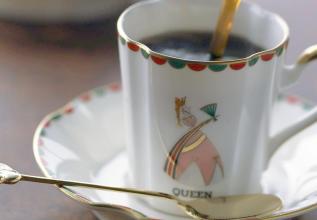Introduction to the flavor and taste characteristics of Panamanian jadeite manor coffee with thick, sour and floral flavor
Panama is located on the Panamanian isthmus in Central America, bounded by Colombia to the east and the Pacific Ocean to the south.
Map of Panama
Map of Panama
It is bordered by Costa Rica to the west and the Caribbean to the north. The territory is S-shaped to connect North and South America, and the Panama Canal connects the Atlantic and Pacific oceans from north to south. It is known as the "bridge of the world". [5] Panama has a land area of 75517 square kilometers, a land length of 772km and a width of between 60km and 177km. The coastline is 2988 kilometers long and the land boundary is 555 kilometers long. In longitude and latitude, Panama is located between 7 °N and 10 °N, and between 77 °and 83 °W. The national emblem of Panama was launched in 1904. The national emblem is a brown eagle with its head held high.
Panamanian national emblem
Panamanian national emblem
It stands on the national emblem with a white ribbon with the Panamanian motto "for the benefit of the world". In the middle of the national emblem is the brown isthmus of Panama, the blue Pacific and Caribbean seas, and the Panama Canal that connects them; under the blue sky, a bright moon has risen, the corresponding sunset is still shining in all directions, symbolizing the arrival of Panama's independence "at sunset and moonrise"; the silver sword and rifle crossed on the upper left have experienced the ups and downs of hundreds of years of war on Panamanian land. The T-pick and shovel on the upper right represent the country's call for active construction and hard work; the sheep's horn overflowing with gold coins and the golden two-winged flywheel symbolize the progress and prosperity of the country. Four national flags are decorated around the national emblem, and the top nine golden five-pointed stars represent the nine provinces of Panama
Panamanian coffee is famous for the rosy summer of the Emerald Manor, which is also famous in the Boquete region of its Chiriqui province. Boquete is a town of Chiriqui in the province of Ricki, located near the border between Panama and Costa Rica, close to the famous Baru Baru volcano, scenic, fertile soil, climate and soil are very suitable for producing quality coffee so there is a very cost-effective bean in the land of Poquette. And it has a very beautiful name-Flower Butterfly. She has 40% high-quality Rosa pedigree, which is composed of Rosa, Kaddura and Kaduai. It is planted in the Baru volcano region of Pokut and grows in the volcanic area at an altitude of 1600 meters. The treatment plant uses fine washing treatment. Panama's special local microclimate leads to abundant rainfall in this area, and a large temperature difference between day and night, coupled with the unique volcanic rock and soil of the volcanic area, as well as meticulous harvesting and fine treatment. Make this coffee excellent in thickness, acidity and floral fragrance. There are many excellent manors in the Pokuit producing area, except the famous Emerald Manor, Alida Manor, Aqaba Manor and so on. All produce high-quality boutique coffee. This is not only due to the superior ecological conditions of the Pokuit region of Panama and the fertile volcanic ash soil of the Baru volcanic land. Another important factor is that the microclimate in the Poquet Heights of Panama is a unique and important resource for boutique coffee in the Pokuit region. This is the environment of Panama from east to west, which allows the cold air to converge above 6500 feet through the Central Mountains, thus creating a variety of microclimates in the Pokuit region, making its temperature and rainfall very suitable for plant growth, so the coffee trees grown here are in very good condition. Boquete is a high-altitude volcanic area, because the Baru Volcano volcano brings quite fertile soil. The towering terrain, cold and humid air, different sunshine, abundant rainfall, and the confluence of rivers create high-quality Panamanian boutique coffee. This batch of coffee, grown in the same area as the Jade Manor, happens to be located in continuous valleys and ridges, so it forms several microclimates, and the coffee produced in different regions has its own flavor. Fresh and comfortable citrus, bright patterns of Nanyang fruit, slender flowers interlaced with a very elegant flavor Central America is a long isthmus from northern Mexico to southern Colombia, connecting North America and North and South Africa. Panama is located in the southernmost part of Central America, so the country runs from east to west, not from north to south as people think. This means that the coast of the Caribbean (Atlantic) is in its north, while the Pacific is in the south.
Panama is by far the narrowest country that shares the Atlantic and Pacific coastlines. And this has a far-reaching impact on coffee production. In the coffee-producing area of Chiriqu í, the hometown of world-famous estates such as Hacienda La Esmeralda, Elida Estate, Finca Nuguo, and Finca La Mula, it is only 60-70 kilometers from the sea.

Important Notice :
前街咖啡 FrontStreet Coffee has moved to new addredd:
FrontStreet Coffee Address: 315,Donghua East Road,GuangZhou
Tel:020 38364473
- Prev

An introduction to the coffee flavor and taste of Coffee Manor in Rwanda with a cool, clear and fresh feeling.
The watershed between the Congo basin and the Nile basin runs through Rwanda from north to south, with about 80 per cent of the country draining from the Nile and about 20 per cent from the Ruzi River and Lake Tanganyika. The longest river in the country is the Niabalongo River (Nyabarongo River) in the southwest, which turns north, east and southeast and flows into the Ruwuwu River to form the Kagaila River.
- Next

Introduction of coffee flavor and taste varieties of Santa Barara Manor in Honduras
Although it is now a backward and chaotic country, this small Central American country is also a region of Mayan civilization, with many relics of Mayan civilization and beautiful tropical seaside scenery. If it were not for such a turbulent situation, it will certainly become a tourist destination. Had it not been for such a turbulent situation, the coffee here would have been better. Honduran coffee comes from Sal.
Related
- Does Rose Summer choose Blue, Green or Red? Detailed explanation of Rose Summer Coffee plots and Classification in Panamanian Jade Manor
- What is the difference between the origin, producing area, processing plant, cooperative and manor of coffee beans?
- How fine does the espresso powder fit? how to grind the espresso?
- Sca coffee roasting degree color card coffee roasting degree 8 roasting color values what do you mean?
- The practice of lattes: how to make lattes at home
- Introduction to Indonesian Fine Coffee beans-- Java Coffee producing area of Indonesian Arabica Coffee
- How much will the flavor of light and medium roasted rose summer be expressed? What baking level is rose summer suitable for?
- Introduction to the characteristics of washing, sun-drying or wet-planing coffee commonly used in Mantenin, Indonesia
- Price characteristics of Arabica Coffee Bean Starbucks introduction to Manning Coffee Bean Taste producing area Variety Manor
- What is the authentic Yega flavor? What are the flavor characteristics of the really excellent Yejasuffi coffee beans?

